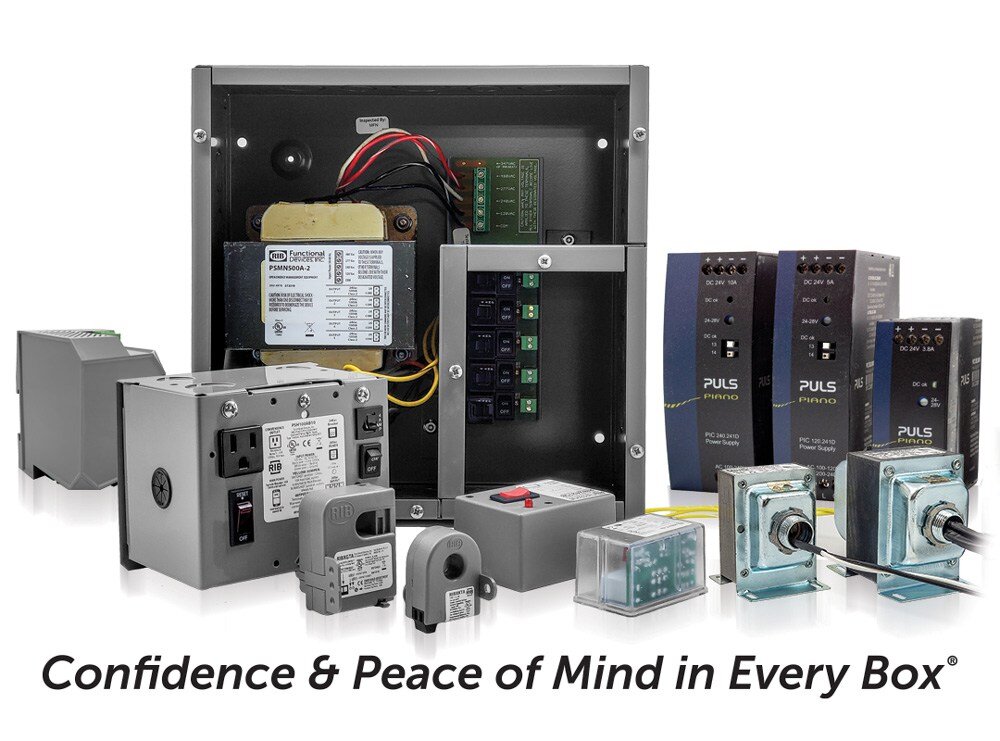Functional Devices has been a trusted supplier of innovative building automation and control products for decades. Our current switches are widely used for monitoring, control, and protection applications. Reach out if you need help selecting, installing, or maintaining these devices.
In this blog, we’ll explore how our self-calibrating current switches provide a smarter way to protect your most valuable mechanical equipment by automatically adjusting to real-world operating conditions.
What Makes Our Self-Calibrating Current Switches Different
Most of our current switches are offered in solid or split-core styles, with fixed or adjustable thresholds, and come with either wire leads or terminals.
Self-calibrating current switches are unique among our offerings and are available in two models, RIBXGA-SCAL (wires for field connection) and RIBXGTA-SCAL (terminal for field connection). Most of our current switches have a normally open output that closes when current through the core exceeds the threshold.
However, the output of the self-calibrating version (-SCAL) is only closed when the current sensed is within a selectable range above and below the threshold. The -SCAL unit calibrates itself and sets the threshold to the nominal current of the load.
To set the threshold, the current switch is clamped around one of the conductors to the load. When current flows through the conductor for the first time, the -SCAL unit begins its calibration process. This lasts for 30 seconds. After that time, the threshold is set at that nominal current.
A DIP switch on the unit allows for re-calibration at any time. A second DIP switch is used to set the threshold differential. The differential is the percentage of current above and below the nominal current that defines the range where the current switch is closed. This range can be set to ±15% or ±25%. For example: If the nominal current of the load is 100 Amps, and the differential is set to ±25%, the output of the current switch would be closed from 75 - 125 Amps.
How Self-Calibration Works
Here’s a step-by-step description of how the self-calibration process works:
- Clamp Around Conductor. Place the self-calibrating switch around a single conductor of the load.
- Initial Calibration. When current flows for the first time, the -SCAL begins a 30-second calibration process, setting its threshold to the nominal current of the load.
- Adjustable Differential. A DIP switch allows recalibration at any time, and a second DIP switch sets the threshold differential to either ±15% or ±25%.
For example, with a 100 A nominal load at ±25%, the switch closes between 75 A and 125 A.
Benefits of Self-Calibrating Current Switches
Having a current switch that is only closed within a range of the nominal current is beneficial in many applications. It can be used to help protect expensive mechanical equipment. The main application is to sense current to a motor, where a current below the range could indicate a belt loss scenario, and a current above the range could indicate a locked rotor scenario. Both states could be detrimental to the equipment.
The addition of the -SCAL unit could alert maintenance of such a situation or be used to shut the equipment down completely, thus preventing damage and downtime. This real-time monitoring helps safeguard motors, pumps, and other expensive equipment by providing actionable feedback on abnormal current draw.
Updated for 2025
In 2025, the -SCAL line continues to be a standout in our current switch portfolio. Enhanced electronics provide improved noise immunity and faster recalibration cycles for modern variable-speed drives and high-efficiency motors. With updated materials and a robust design, the RIBXGA-SCAL and RIBXGTA-SCAL integrate seamlessly into today’s advanced building automation systems, offering precise, reliable current monitoring to protect critical infrastructure.
FAQ: Self-Calibrating Current Switches
Q: What’s the difference between self-calibrating and fixed-threshold current switches?
A: Self-calibrating models automatically adjust to the nominal load current, whereas fixed-threshold models require manual setting.
Q: Can I recalibrate the -SCAL units after installation?
A: Yes. A DIP switch allows recalibration whenever the load conditions change.
Q: What differential settings are available?
A: You can choose ±15% or ±25% of the nominal load current.
Q: Can the -SCAL switches integrate with my existing BAS or alarm system?
A: Yes. They provide a standard dry contact output compatible with most controllers, relays, and monitoring systems.
Ready to Protect Your Equipment?
Functional Devices designs solutions that help you monitor, control, and safeguard your systems more effectively. Our self-calibrating current switches are the ideal choice for facilities looking to reduce downtime, prevent damage, and simplify installation. Contact our team today to learn how the RIBXGA-SCAL or RIBXGTA-SCAL can protect your most valuable equipment.
If you would like more information about our self-calibrating current switch, read through the datasheet or give us a call.
About Functional Devices, Inc.

Functional Devices, Inc., located in the United States of America, has been designing and manufacturing quality electronic devices since 1969. Our mission is to enhance lives in buildings and beyond. We do so by designing and manufacturing reliable, high-quality products for the building automation industry. Our suite of product offerings include RIB relays, current sensors, power controls, power supplies, transformers, lighting controls, and more.
We test 100% of our products, which leads to less than 1 out of every 16,000 products experiencing a failure in the field.
Simply put, we provide users of our various products confidence and peace of mind in every box.


